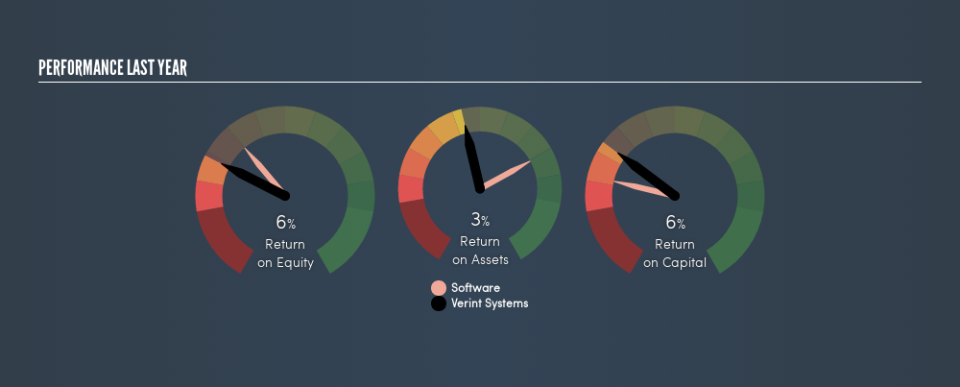How Do Verint Systems Inc.’s (NASDAQ:VRNT) Returns On Capital Compare To Peers?

Today we are going to look at Verint Systems Inc. (NASDAQ:VRNT) to see whether it might be an attractive investment prospect. To be precise, we'll consider its Return On Capital Employed (ROCE), as that will inform our view of the quality of the business.
First up, we'll look at what ROCE is and how we calculate it. Next, we'll compare it to others in its industry. Last but not least, we'll look at what impact its current liabilities have on its ROCE.
Understanding Return On Capital Employed (ROCE)
ROCE is a metric for evaluating how much pre-tax income (in percentage terms) a company earns on the capital invested in its business. All else being equal, a better business will have a higher ROCE. Ultimately, it is a useful but imperfect metric. Renowned investment researcher Michael Mauboussin has suggested that a high ROCE can indicate that 'one dollar invested in the company generates value of more than one dollar'.
How Do You Calculate Return On Capital Employed?
The formula for calculating the return on capital employed is:
Return on Capital Employed = Earnings Before Interest and Tax (EBIT) ÷ (Total Assets - Current Liabilities)
Or for Verint Systems:
0.056 = US$129m ÷ (US$3.0b - US$661m) (Based on the trailing twelve months to April 2019.)
Therefore, Verint Systems has an ROCE of 5.6%.
View our latest analysis for Verint Systems
Is Verint Systems's ROCE Good?
ROCE is commonly used for comparing the performance of similar businesses. We can see Verint Systems's ROCE is meaningfully below the Software industry average of 10.0%. This performance could be negative if sustained, as it suggests the business may underperform its industry. Regardless of how Verint Systems stacks up against its industry, its ROCE in absolute terms is quite low (especially compared to a bank account). There are potentially more appealing investments elsewhere.
In our analysis, Verint Systems's ROCE appears to be 5.6%, compared to 3 years ago, when its ROCE was 2.8%. This makes us think the business might be improving. The image below shows how Verint Systems's ROCE compares to its industry, and you can click it to see more detail on its past growth.
Remember that this metric is backwards looking - it shows what has happened in the past, and does not accurately predict the future. ROCE can be misleading for companies in cyclical industries, with returns looking impressive during the boom times, but very weak during the busts. This is because ROCE only looks at one year, instead of considering returns across a whole cycle. What happens in the future is pretty important for investors, so we have prepared a free report on analyst forecasts for Verint Systems.
Do Verint Systems's Current Liabilities Skew Its ROCE?
Liabilities, such as supplier bills and bank overdrafts, are referred to as current liabilities if they need to be paid within 12 months. Due to the way the ROCE equation works, having large bills due in the near term can make it look as though a company has less capital employed, and thus a higher ROCE than usual. To counteract this, we check if a company has high current liabilities, relative to its total assets.
Verint Systems has total assets of US$3.0b and current liabilities of US$661m. Therefore its current liabilities are equivalent to approximately 22% of its total assets. This is not a high level of current liabilities, which would not boost the ROCE by much.
Our Take On Verint Systems's ROCE
That's not a bad thing, however Verint Systems has a weak ROCE and may not be an attractive investment. You might be able to find a better investment than Verint Systems. If you want a selection of possible winners, check out this free list of interesting companies that trade on a P/E below 20 (but have proven they can grow earnings).
If you like to buy stocks alongside management, then you might just love this free list of companies. (Hint: insiders have been buying them).
We aim to bring you long-term focused research analysis driven by fundamental data. Note that our analysis may not factor in the latest price-sensitive company announcements or qualitative material.
If you spot an error that warrants correction, please contact the editor at editorial-team@simplywallst.com. This article by Simply Wall St is general in nature. It does not constitute a recommendation to buy or sell any stock, and does not take account of your objectives, or your financial situation. Simply Wall St has no position in the stocks mentioned. Thank you for reading.

 Yahoo Finance
Yahoo Finance 
